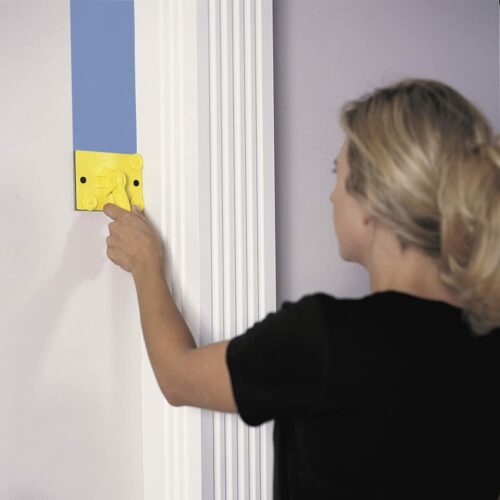Paint drips are a common problem when painting a woodworking project, cabinets, a wall, or wood trim. They can be especially frustrating when they dry before you notice them. Most of the time, paint drips happen when you put too much paint on your project in one coat. This usually happens when you use a paintbrush or roller that is too full. Gravity makes the extra paint run, and as the paint starts to dry, it forms drips that can be seen.
If you move a paint roller across a wall too quickly, the paint will drip, and if the roller is too full, it will leave streaks that won’t go away when the paint dries. The good news is that you can remove and fix paint drips, splatters, and streaks even after the paint has dried by buffing out the runs with sandpaper. It’s even easier if you catch them while the paint is still wet.
Table of Contents
How to Fix Paint Drips

Before Starting
Set up a strong light source that can shine on the drips as they happen to help you find them while they are still wet. This type of light is often just a simple utility lamp that you can put on the ground or clamp to a pole, ladder, or another object to shine directly on the wall or object you are painting. It is often called a “raking” light. So you can find the drip as soon as it starts, the light makes the shadows and raised spots to stand out. It also helps you find drips that aren’t wet.
What You Need to Know
- Equipment / Tools
- Paintbrush
- Clean a scraper, razor blade, or 5-in-1 tool
- Putty knife
- Small drywall knife
- Materials
- 220-grit sandpaper
- Glazing putty
How to Fix Paint Drips: Instructions
- Things to fix paint drips and how to use them
- Margot Cavin’s The Spruce
- Remove Drops from Wet Paint
If you catch the paint drip while the paint is still pretty wet, you can probably brush it out. Try a few strokes with the paintbrush and see what happens. If this doesn’t stop the drip and the paint still feels sticky, stop brushing. The paint is already too dry, and more brushing will only make the problem worse.
Tip
The trick is to use the same direction for the brush strokes as you did for the rest of the painting. Don’t try to stop the drip by brushing in the opposite direction. This usually makes it ugly, and hard to get rid of cross-strokes.
Allow the Paint to Dry
If the paint feels sticky when you touch it, you should let the paint drip (and the area around it) dry completely before trying to fix it. If the paint is still wet, it may come off when you scrape or sand it, making the problem even worse.
- Paint drips and dries
- Sand or scrape the drip.
A paint drip makes a raised spot that stands out because the paint is shiny. After the paint has dried, the first step is to cut or sand down the raised area. Start by using a clean scraper, razor blade, or 5-in-1 tool to lightly scrape down the drip. The less damage you do to the area around you, the better.
After you’ve taken off the raised part of the drip, try using 220-grit sandpaper to get rid of the remaining mark. Sand only in the direction of the drip. If you sand back and forth or in the opposite direction of the drip, the paint will stick together or flake off, making the spot bigger. Be careful to only sand the drip and not the paint around it.
A scraper was used to pick up a small paint drip.
Repair Any Damage
Even if you try hard, you might scrape or sand into the paint too much. If there is a hole where the drip was or if your repair work caused other damage, you can fill the hole with glazing putty-like Bondo.
Spread the putty on with a putty knife, and then use a small drywall knife to remove the extra. Let the putty dry, and then sand it as shown.
Tip
It’s best to prime the puttied area first to avoid problems with the topcoat. If paint is put on directly over putty, it can sometimes get pinholes or look blotchy, which is called paint flash.
With a small drywall knife, the extra glazing putty was scraped off.
Paint the area again.
- Once you are sure that the drip has been completely flattened, add one or two more coats of paint. When the paint is dry, the mark should be hard to see.
- White paint was put on again with a paint roller.
- After wiping up a drip, I was done painting the wall.
FAQ
How do I fix drips of paint from spray paint?
When a thick layer of paint is sprayed onto a surface, it tends to drip in many places. If the paint is still wet, take a paintbrush and lightly paint over the drips. If the drips are dry, you’ll need to cut them out and sand the edges (as described in the steps above), then paint over them with very light, thin coats as you go. But if you use a paint sprayer, you have to be skilled and know how to use it well to avoid drips.
How do you prevent paint drips?
When you paint with a brush, don’t put too much paint on it or the paint will drip. If you’re painting with a roller, move it slowly and steadily over the wall to avoid drips and splatters. When painting a ceiling with a roller, it’s easy for paint to get everywhere, so don’t put too much paint on the tool.
Can I sand down drips of paint?
Yes, but the steps above show how to do it in two steps. First, cut off the raised part of the drip. Then, use sandpaper with the right grit to get rid of the rest of the raised edges.


